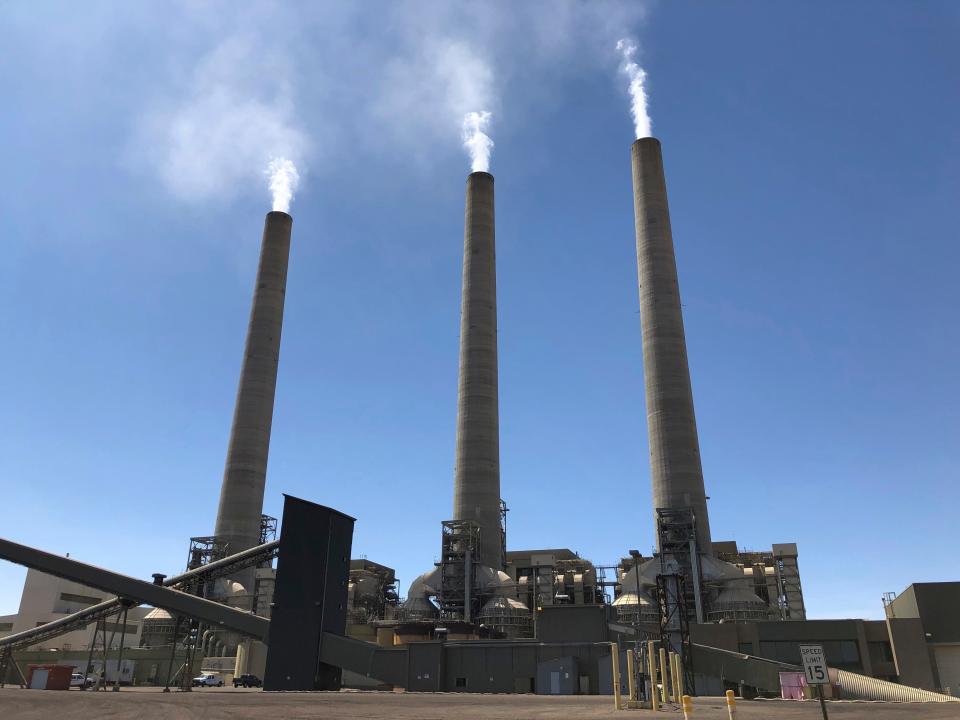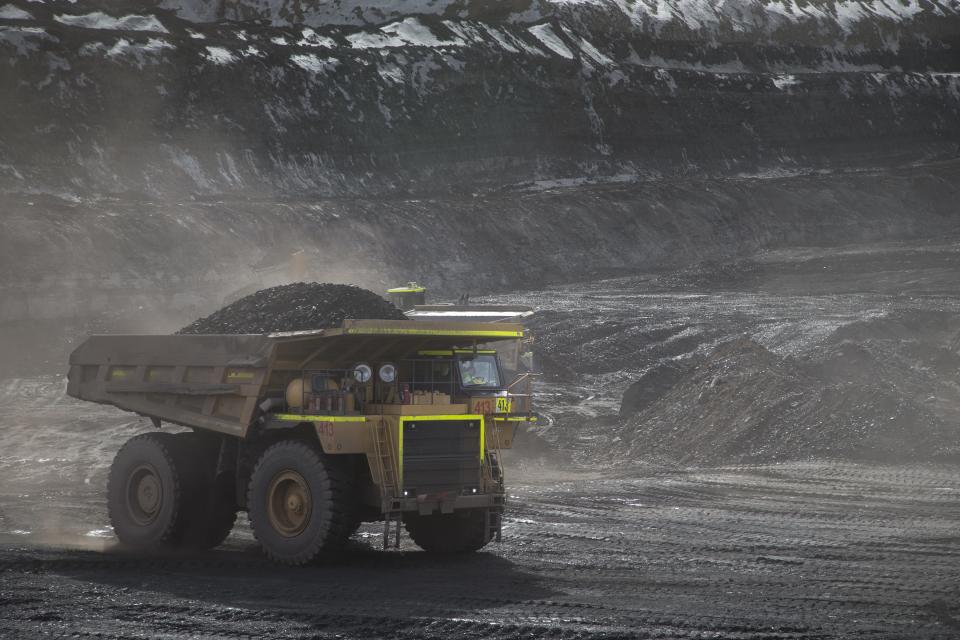Pollution from coal-fired power plants led to hundreds of deaths in Arizona, NM, study says
An estimated 460,000 people died of causes attributed to fine particulates from coal power generating stations nationwide, according to a new study, which examined so-called "excess deaths" between 1999 and 2020.
Three of the plants in the study operated in northern Arizona or in New Mexico along the edges of the Navajo Nation.
Exposure to the fine coal dust, known as PM2.5 based on the size of the particles, led to a mortality risk two times greater than exposure to fine particulates from other sources, the study found.
“Air pollution exposure is associated with adverse health effects and increased risk of death,” according to the study "Mortality risk from United States coal electricity generation." “Coal electricity-generating units, or power plants, are a major contributor to poor air quality.”
Researchers compared mortality risks associated with fine particulate exposure from coal and from all other sources, then analyzed Medicare death records covering 650 million person-years in the U.S. Annual excess deaths were highest between 1999 and 2007, averaging more than 43,000 deaths per year for a total of 390,000.
About 480 U.S. coal-powered plants operated from 1999 to 2020, including Four Corners Generating Station and San Juan Generating Station in New Mexico, and the now demolished Navajo Generating Station in the Lechee community of the Navajo Nation outside Page. That plant closed in 2019.

Fewer than 1,000 people died of causes resulting from fine particulates emitted from power plants on or near the Navajo Nation, but that is likely an undercount, according to Lucas Hennema, the study's lead researcher.
“We are capturing deaths in the U.S. Medicare population," he said in an email to The Arizona Republic, "so the actual impact from the facilities is likely larger than the values we report.”
Four Corners Generating Station is connected to at least 460 deaths related to fine particulates. San Juan Generating Station listed about 310 deaths, and Navajo Generating Station is linked to about 100 deaths due to fine particulates.
Navajo Generating Station: Navajo residents seek 'just and equitable' help after closure of power plant, coal mine
Seeking an equitable transition
Coal-fired plants east of the Mississippi River were associated with the greatest numbers of deaths because of their high emissions and proximity to population centers, the study found. But the effects on the land, water, animals and people from Navajo Generating Station and coal mines such as Black Mesa and Kayenta, linger to this day, which is why Navajo environmental groups continue to push for an equitable transition.
Some of their current projects are related to the idea of what they call a just and equitable transition from a coal-related economy, "because we are coming from decades of resource extraction, fossil fuel use revenue that our tribes have been dependent on and to some degree still are,” said Robin Jackson, Diné C.A.R.E., during a recent Indigenous Just Transition Southwest Regional Gathering. “We need to encourage them to look into more sustainable, regenerative, renewable forms of economic development.”
Navajo Generating Station was the West’s largest coal plant, with three 775-foot smokestacks alongside the 2,250-megawatt plant. After its closure in 2019, Diné CARE, along with partners like Tó Nizhóní Ání (Sacred Water Speaks) and the Black Mesa Water Coalition, launched the Navajo Equitable Economy Initiative.
The initiative focuses on five areas: ending coal operations regionally, transition funding from utilities, land and water reclamation, clean energy development, and community voice in projects, according to the Diné C.A.R.E. website.
“There is still a mindset stuck on keeping fossil fuel development going,” said Jackson, “other than developing other forms of economic development that's not based on fossil fuel. So we actually were involved with other people to prevent our Navajo Nation from continuing the Navajo Generating Station because that would not have been a good deal for our people. That would’ve allowed for more pollution into the environment.”
Nicole Horseherder, executive director of Tó Nizhóní Ání, said during the gathering at NAU that the end of coal on Navajo is approaching and transition is happening, but what transition means varies from person to person.
“We have been fighting coal mining and water mining for the past 50 years for those who are from Black Mesa,” said Horseherder. “We definitely see a transition on the horizon and it's important for us to stay involved. When I think of transition I think of this loose mess as coal mines start to shut down, and coal plants come down.”
Power plant: As coal mines depleted a Navajo Nation aquifer, feds failed to flag losses, report says
Why activists say it's important to get involved now
The complexity of transition is easier than dealing with the disorder of when coal ruled across the Black Mesa, Horseherder said. She described the time when NGS was still operating and connected to the Kayenta Mine, and the Mohave Generating Station in Nevada was connected to the Black Mesa mine, as a “tangled, really knotted up mess.”
“We had water crossing basin lines, state lines, we had coal leases exclusive to coal plants,” said Horseherder. “We had Navajo Nation being coerced to wave its water on the upper basin Colorado River, give away rights-of-way for free, then having to share revenues with the rest of the state. What was given to the nation was probably what was given to the county. A big rip-off all the way around. The mess of transition is probably a little easier to deal with.”
Anyone who has dealt with the shutdown of the mines understands that being a part of what’s to come next is important, she said, because if you aren’t working on what's to come, someone else will make that decision. She noted the Navajo Nation is surrounded by seven coal-fired power plants.
“As those coal plants come down everyone is eyeing those coal plants because the transmission lines are there,” she said. “Transmission lines are not going to come down like the way the rest of the infrastructure came down. They’re very valuable. The utilities own them, probably in the same ratio that they own the coal plant, so they got something planned already. It is important for us to get out front and have a say in what happens next.”
Resource development: Navajo Nation president vetoes a plan to explore for helium near 2 tribal communities
How a plant lease renewal reverberated for years
Dr. Andrew Curley, University of Arizona professor in the School of Geography, has been researching the coal industry and the politics that surrounded it in the Navajo Nation for over a decade. His book ‘Carbon Sovereignty: Coal, Development, and Energy Transition in the Navajo Nation’ delves deep into coal development in the Navajo Nation, and how the tribe intended to use the coal industry in support of sovereignty.
It's a book that traces the history of how the Navajo Nation gave Phoenix and Tucson water and supplied electricity to Arizona, California and Nevada for practically nothing through the Lechee plant and coal mines located on Navajo. In explaining the connections, the book coins the phrase "carbon treatymaking."
“For colonizers, these powers need to access resources in and around reservations. I refer to this concession process between tribes and colonizers as carbon treatymaking, an extension of the idea of carbon sovereignty and its inherent limitation,” Curley wrote. An example of this is the 2013 NGS lease renewal.

In 1969, the Navajo Nation Council signed the original land lease for the Navajo Generating Station, and in 2013 the lease renewal came up for debate at the Navajo Nation Council.
This was “an example of modern-day treaty-making,” wrote Curley.
“Navajo Nation Council delegates were concerned about land leases for strip-mining, water rates for coal production, the land lease over the railway… the land lease for the actual power plant itself,” he wrote. “Tribal sovereignty was understood but performed in the context of colonial capitalism.”
In 2013, the Navajo Nation was asked to forego water claims to the Colorado River and exempt the lease site from tribal sovereignty. The two major limitations were labor rights for Navajo workers and rights to 34,000 acre feet of Colorado River water.
“The 2013 lease, like treaties before it, set conditions on Navajo jurisdiction and the use of Diné resources in exchange for monetary goods and investments in infrastructure,” Curley wrote.
Even if the finding of excess death attributed to fine particulates emitted from coal-fired plants was minimal in and around the Navajo Nation compared to plants in the eastern U.S., the harm done environmentally, socially, politically, and economically through the Navajo Nation is evident and documented.
"Large decreases in annual deaths across the study period highlight the success of emissions reductions brought about by regulations under the 1990 Clean Air Act Amendments," the study's authors wrote. "Although coal use in the U.S. has remained low, global use is expected to increase and plateau by 2025, suggesting the potential for high mortality costs from coal for years to come."
Arlyssa Becenti covers Indigenous affairs for The Arizona Republic and azcentral. Send ideas and tips to arlyssa.becenti@arizonarepublic.com.
Support local journalism. Subscribe to azcentral.com today.
This article originally appeared on Arizona Republic: Hundreds in AZ, NM died from coal-fired power plant dust, study says

